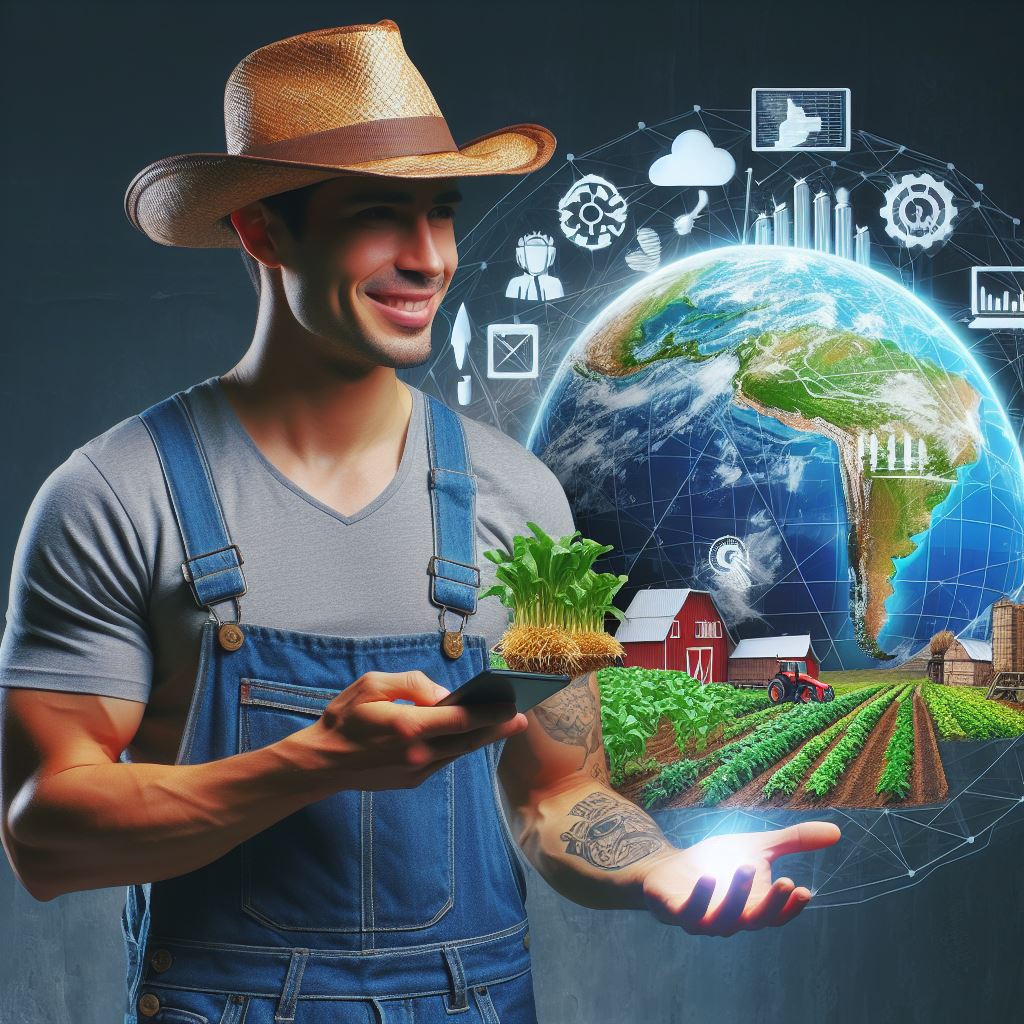Introduction
Agriculture’s tech integration enhances efficiency, productivity, and sustainability.
This revolutionizes farming globally, shaping a dynamic market.
The integration of technology in the global farming market has revolutionized the industry:
- Enhanced Efficiency
- Increased Productivity
- Sustainable Practices
Tech tools streamline operations, from planting to harvesting, optimizing resource utilization.
Precision agriculture techniques minimize waste, maximizing yields while conserving resources.
Global farming adapts, incorporating IoT, AI, and drones for real-time monitoring and data-driven decisions.
These innovations empower farmers, fostering resilience against climate change and market fluctuations.
To summarize, technology’s role in modern farming is pivotal, driving a global market revolution.
Evolution of Technology in Agriculture
A. Historical overview of technological advancements in farming
In the early days, farming was a labor-intensive process that relied on manual tools and human power.
With the invention of the plow, farmers were able to increase their productivity and cultivate larger areas of land.
The Industrial Revolution brought about significant advancements in farming technology, such as the introduction of the steam engine and mechanical reapers.
These innovations greatly reduced the amount of manual labor required and allowed farmers to produce more crops efficiently.
B. Impact of mechanization on agriculture
The mechanization of agriculture revolutionized the industry, making it possible to produce food on a large scale.
Farmers no longer had to rely solely on human and animal labor; instead, they could harness the power of machines.
Tractors replaced horses for plowing and tilling the soil, while combine harvesters made the process of harvesting much faster and more efficient.
Transform Your Agribusiness
Unlock your farm's potential with expert advice tailored to your needs. Get actionable steps that drive real results.
Get StartedMechanization increased productivity, reduced costs, and enabled farmers to meet the growing demand for food.
C. Introduction of computers and automation
The introduction of computers and automation further transformed agriculture in the late 20th century.
Farmers began using computer systems to manage inventory, track production, and monitor weather conditions.
Automation technology, such as automatic irrigation systems and robotic milking machines, improved efficiency and reduced the need for manual labor.
Farmers could now rely on data analysis and precision technology to make informed decisions for optimal crop growth and yield.
D. Emergence of precision agriculture
Precision agriculture is a farming approach that utilizes technology to optimize production and minimize waste.
Sensors and GPS systems are used to collect data on soil conditions, crop health, and weather patterns.
This data is then analyzed to determine the precise amount of fertilizers, water, and pesticides needed for each specific area of the field.
Precision agriculture allows farmers to maximize yields while minimizing the use of inputs, reducing environmental impact and increasing profitability.
E. Introduction of Internet of Things (IoT) and artificial intelligence
The integration of the Internet of Things (IoT) and artificial intelligence (AI) has taken agriculture technology to another level.
Farmers can now remotely monitor and control various aspects of their operations, such as irrigation, livestock feeding, and crop health.
AI algorithms analyze vast amounts of data to provide insights and predictions, helping farmers make more accurate decisions.
Smart farming systems can detect diseases, pests, and nutrient deficiencies early on, allowing for timely interventions and higher crop quality.
Therefore, the evolution of technology in agriculture has revolutionized the industry, increasing productivity, efficiency, and sustainability.
From historical advancements in mechanization to the introduction of computers and precision agriculture, farmers have embraced technological innovations.
With the integration of IoT and AI, farming has become smarter and more data-driven, leading to improved decision-making and better outcomes for farmers and the environment.
Read: Climate Change: Shaping Global Agri Trade
The Global Market Revolution
A. Adoption of technology in farming worldwide
In recent years, there has been a remarkable shift in the agricultural sector, with farmers around the world embracing various technological advancements to improve their farming practices.
From drones and robots to precision agriculture and artificial intelligence, the adoption of technology has revolutionized the way farming is done globally.
These technological advancements have allowed farmers to collect and analyze vast amounts of data, enabling them to make more informed decisions about their crops and livestock.
With the help of advanced sensors and imaging technology, farmers can monitor soil health, detect diseases, and optimize irrigation, leading to increased productivity and efficiency in farming operations.
Furthermore, the use of automation and robotics has not only reduced labor costs but also improved the overall efficiency of farming processes.
For instance, autonomous drones can be deployed to spray fertilizers or pesticides accurately, eliminating the risks associated with manual applications and reducing environmental impacts.
B. Increased global demand for food and its impact on farming practices
As the global population continues to grow at an unprecedented rate, the demand for food has increased significantly.
Showcase Your Farming Business
Publish your professional farming services profile on our blog for a one-time fee of $200 and reach a dedicated audience of farmers and agribusiness owners.
Publish Your ProfileThis surge in demand poses various challenges to the agricultural industry, pushing farmers to explore innovative ways to meet the world’s food requirements.
To address this increasing demand, farmers have turned to technology to optimize their farming practices.
With the help of advanced machinery and equipment, they can produce higher crop yields on limited land, ensuring sustainable and efficient food production.
Moreover, technology has enabled farmers to overcome the limitations imposed by climate change and unpredictable weather patterns.
Through the use of precision farming techniques, farmers can adapt to changing environmental conditions, allowing them to grow crops in areas previously unsuited for agriculture.
C. Technological advancements driving the global market revolution
The rapid pace of technological advancements has been a driving force behind the global market revolution in farming.
Innovations such as genetic engineering and biotechnology have enabled the development of high-yielding crop varieties, resistant to pests and diseases.
Additionally, the integration of data analytics and artificial intelligence has revolutionized farming practices.
Farmers can now harness the power of predictive analytics to optimize planting schedules, reduce wastage, and maximize crop yields.
Furthermore, the rise of vertical farming and hydroponics has facilitated the cultivation of crops in controlled environments, independent of traditional agricultural constraints.
These systems utilize advanced lighting, climate control, and nutrient delivery technologies to create optimal growing conditions, leading to increased efficiency and productivity.
Most importantly, the global market revolution in farming is a result of the widespread adoption of technology.
From precision agriculture and automation to genetic engineering and data analytics, technological advancements have transformed the way farming is done worldwide.
With the ever-increasing demand for food, innovation in farming practices is crucial to ensure sustainable and efficient food production for the growing global population.
Read: Global Organic Markets: Farming’s Future?

Improved Efficiency and Productivity
Technological advancements are revolutionizing farming practices, leading to improved efficiency and productivity.
Farmers are increasingly adopting innovative technologies to improve their yield and make better use of available resources.
This section explores some of the key advancements in technology that contribute to improved efficiency and productivity in farming.
A. Use of drones and satellite imaging for crop monitoring
One significant development is the use of drones and satellite imaging for crop monitoring.
Farmers can now use drones equipped with cameras and sensors to capture high-resolution images of their fields.
These images can then be analyzed to identify crop health issues, nutrient deficiencies, and pest infestations.
By detecting these problems early, farmers can take timely action, such as targeted spraying or fertilization, to minimize yield loss.
B. Automation and robotics for labor-intensive tasks
Automation and robotics also play a crucial role in improving efficiency and productivity in farming.
Labor-intensive tasks like harvesting and planting can be time-consuming and costly.
However, with the advent of automation and robotics, farmers can now rely on machines to perform these tasks accurately and efficiently.
This not only reduces labor costs but also enables faster and more precise operations, resulting in increased productivity.
C. GPS and navigation systems for precision farming
The use of GPS and navigation systems in precision farming further enhances efficiency.
With GPS technology, farmers can precisely map their fields and create virtual boundaries.
This allows for accurate planting, spraying, and fertilizing, eliminating overlaps and reducing resource wastage.
Navigation systems also assist in guiding autonomous machinery, ensuring they follow predetermined paths without human intervention.
D. Advantages of smart irrigation systems
Smart irrigation systems offer several advantages in terms of efficiency and resource management.
These systems use sensors and data analytics to monitor soil moisture levels and weather conditions.
By analyzing this data, farmers can optimize irrigation schedules, preventing both overwatering and underwatering.
This not only conserves water but also ensures that crops receive the right amount of moisture for optimal growth.
E. Integration of data analytics for decision-making
The integration of data analytics into farming practices provides valuable insights for decision-making.
By collecting and analyzing data on crop performance, weather patterns, and resource usage, farmers can make data-driven decisions.
They can adjust their planting strategies, optimize resource allocation, and even predict crop yields.
This allows for better planning, reduced waste, and improved overall efficiency on the farm.
In essence, advancements in technology have significantly improved efficiency and productivity in farming.
The use of drones and satellite imaging, automation and robotics, GPS and navigation systems, smart irrigation, and data analytics have revolutionized agricultural practices.
Showcase Your Farming Business
Publish your professional farming services profile on our blog for a one-time fee of $200 and reach a dedicated audience of farmers and agribusiness owners.
Publish Your ProfileThese technologies enable farmers to monitor their crops more effectively, perform labor-intensive tasks efficiently, optimize resource usage, and make informed decisions.
Embracing these technological advancements is essential for farmers to maximize their yield and contribute to the global market revolution in agriculture.
Read: EU Trade Policies and US Farm Exports
Learn More: Agri Policy Changes: Stay Ahead in 2024
Find Out More: Farm Product Global Market Entry
Sustainable Farming Practices
A. Impact of Technology on Sustainable Farming
- Technology revolutionizes sustainable farming, enhancing efficiency and environmental stewardship.
- Innovations like precision agriculture optimize resources, minimize waste, and improve crop yields.
- Remote sensing tools provide real-time data, aiding in decision-making for sustainable practices.
- Drones and satellite imagery monitor crop health, enabling targeted interventions and reducing chemical usage.
- IoT devices track environmental parameters, ensuring optimal conditions for plant growth.
B. Reduction of Water Usage through Sensor Technology
- Sensor technology monitors soil moisture levels, enabling precise irrigation scheduling.
- Smart irrigation systems deliver water directly to roots, minimizing evaporation and runoff.
- Real-time data analysis helps farmers optimize water usage, conserving this precious resource.
- Water-saving technologies reduce costs and alleviate pressure on dwindling water supplies.
- Sustainable farming practices ensure water remains available for future generations.
C. Precision Fertilization and Pest Control Techniques
- Precision fertilization delivers nutrients directly to plants, reducing excess runoff and pollution.
- Integrated pest management utilizes technology to monitor pest populations and deploy targeted interventions.
- Biological controls and pheromone traps minimize reliance on chemical pesticides, preserving ecosystem balance.
- Data-driven insights enable farmers to anticipate pest outbreaks and take proactive measures.
- Sustainable pest control practices protect biodiversity and promote long-term ecological health.
D. Soil Health Monitoring and Management
- Soil sensors assess key parameters like moisture, pH, and nutrient levels, guiding soil management decisions.
- Conservation tillage practices reduce soil erosion and promote organic matter retention.
- Cover crops improve soil structure, enhance water infiltration, and suppress weeds.
- Soil carbon sequestration techniques mitigate climate change impacts and enhance soil fertility.
- Sustainable soil management preserves arable land for future generations.
E. Utilization of Renewable Energy Sources in Farming Operations
- Solar panels power irrigation systems, farm machinery, and processing facilities, reducing reliance on fossil fuels.
- Wind turbines generate electricity for on-farm operations, offsetting carbon emissions and reducing energy costs.
- Biogas digesters convert organic waste into renewable energy and nutrient-rich fertilizers.
- Sustainable energy sources lower greenhouse gas emissions and contribute to a cleaner environment.
- Integration of renewables fosters energy independence and resilience in agricultural communities.
All in all, technology plays a pivotal role in driving sustainable farming practices, ensuring the longevity of agriculture while safeguarding the planet’s resources for future generations.
Read: Latin America: A Farm Export Powerhouse?
Challenges and Future Implications
A. Affordability and accessibility of technology for small-scale farmers
- Small-scale farmers face challenges in affording and accessing advanced farming technologies.
- The high cost of technology and limited availability hinder small-scale farmers from adopting it.
- Lack of financial resources makes it difficult for small-scale farmers to invest in technology.
- Improving affordability and accessibility is crucial to ensure the inclusion of all farmers.
- Government and private sector collaborations can help provide technology at affordable prices.
- Creating subsidies and support programs can make technology more accessible to small-scale farmers.
B. Training and education for farmers to adopt and utilize technology effectively
- Farmers need proper training and education to maximize the benefits of technology.
- Knowledge gaps regarding technology can hinder effective adoption and utilization.
- Training programs should focus on teaching farmers how to operate and maintain technology.
- Providing technical support and assistance can help farmers overcome challenges they may face.
- Collaborations between technology providers and agricultural institutions can enhance training opportunities.
C. The role of government policies and regulations in promoting technology adoption
- Government policies and regulations play a vital role in encouraging technology adoption in farming.
- Favorable policies can provide incentives, subsidies, and tax benefits to farmers adopting technology.
- Regulations should be developed to ensure the safety and efficiency of farming technology.
- Streamlining approval processes for new technologies can promote quicker adoption.
- Governments should also invest in research and development to promote innovation in farming technology.
- Collaborations between government and industry can lead to effective policy implementation.
D. Potential of emerging technologies like blockchain and vertical farming in the future
- Emerging technologies such as blockchain and vertical farming have promising implications for the future.
- Blockchain technology can enhance transparency, traceability, and efficiency in the agricultural supply chain.
- Vertical farming allows for efficient use of space and resources, potentially increasing yield and sustainability.
- Both technologies can contribute to improving food security and reducing environmental impact.
- Investment and research in these emerging technologies are important for future agricultural advancements.
- Collaborations between technology companies and farmers can help pilot and scale these technologies.
In fact, the adoption of technology in farming brings both opportunities and challenges.
Affordability and accessibility are key challenges, especially for small-scale farmers.
Training and education are essential to ensure effective utilization of technology.
Government policies and regulations play a crucial role in promoting technology adoption.
Furthermore, emerging technologies like blockchain and vertical farming hold immense potential for the future.
Addressing these challenges and embracing the potential of technology can revolutionize the global farming market.
Conclusion
A. The revolution brought by technology in farming
Technology revolutionized farming globally, enhancing efficiency, productivity, and sustainability.
- Precision agriculture optimizes resource usage.
- Automation streamlines labor-intensive tasks.
- IoT sensors monitor crops and livestock health.
- AI predicts optimal planting and harvesting times.
- Drones provide aerial crop surveillance.
- Vertical farming maximizes space utilization.
- Genetic engineering enhances crop resilience.
- Blockchain ensures transparent supply chains.
B. Benefits of improved efficiency, increased productivity, and sustainability
Improved efficiency translates to cost savings and higher yields.
- Reduced resource wastage boosts profitability.
- Streamlined processes minimize manual errors.
- Faster data analysis informs timely decisions.
- Increased yields meet growing food demands.
- Sustainable practices preserve the environment.
C. Future prospects and potential of technology in transforming the farming industry
The future holds immense potential for further technological advancements.
- AI and machine learning will refine predictions.
- Robotics will automate more farm tasks.
- Biotechnology will create drought-resistant crops.
- Sustainable energy sources will power farms.
- Data analytics will drive precision farming.
- Connectivity will foster smarter farming networks.
- Continued innovation will shape agriculture’s future.
In the end, technology’s transformative impact on farming promises a sustainable and productive future.




